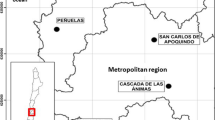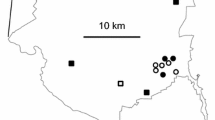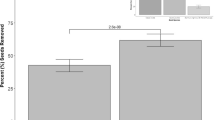Abstract
There is still little information on effects of habitat degradation on post-dispersal seed predation at the landscape scale. The aim of this study was to determine the influence of habitat degradation and seed species on the variability of post-dispersal seed-predation rate. Experimental seed removal was investigated in six Mediterranean woody plant species, four trees (Pinus sylvestris, Quercus ilex, Acer opalus ssp. granatense, and Sorbus aria) and two shrubs (Berberis vulgaris and Crataegus monogyna), in an extensively used mosaic landscape on the Sierra Nevada massif (SE Spain). Seed depots were distributed over 2 years in five differently degraded landscape units, each one with three plots: shrubland; native forest; and dense, cleared and fenced reforestation stands. Predation was the highest in native forest, shrubland, and fenced reforestation, and the lowest in dense and cleared reforestation stands, being partially due to a positive correlation between shrub cover and post-dispersal seed predation. However, the main factors driving post-dispersal seed predation were intrinsic to seeds, as species preference explained most of the variance in our model for predation. The plant-species ranking was Quercus > Pinus > Sorbus > Berberis > Acer > Crataegus, the dominant tree species being the most depredated. These findings are novel because they suggest for the first time that species-selection patterns by post-dispersal seed predators tended to remain constant through both study years in all habitats comprising a mosaic landscape, whether native forest, reforestation stands or successional shrubland.



Similar content being viewed by others

References
Alcántara JM, Rey PJ, Sánchez-Lafuente AM, Valera F (2000) Early effects of rodent post-dispersal seed predation on the outcome of the plant-seed disperser interaction. Oikos 88:362–370. doi:10.1034/j.1600-0706.2000.880215.x
Barnea A, Harborne JB, Panell C (1993) What parts of fleshy fruits contain secondary compounds toxic to birds and why? Biochem Syst Ecol 21:421–429. doi:10.1016/0305-1978(93)90100-6
Burkey TV (1993) Edge effects in seed and edge predation at two neotropical rainforest sites. Biol Conserv 66:139–143. doi:10.1016/0006-3207(93)90145-Q
Caccia FD, Chaneton EJ, Kitzberger T (2006) Trophic and non-trophic pathways mediate apparent competition through post-dispersal seed predation in a Patagonian mixed forest. Oikos 113:469–480. doi:10.1111/j.2006.0030-1299.14390.x
Castro J, Gómez JM, García D, Zamora R, Hódar JA (1999) Seed predation and dispersal in relict Scots pine forests in southern Spain. Plant Ecol 145:115–123. doi:10.1023/A:1009865703906
Crawley MJ (1992) Seed predators and plant population dynamics. In: Fenner M (ed) Seeds: the ecology of regeneration in plant communities. CABI, London, pp 157–191
Davidson DW (1993) The effects of herbivory and granivory on terrestrial plant succession. Oikos 68:23–35. doi:10.2307/3545305
Delgado R, Delgado G, Párraga J, Gámiz E, Sánchez M, Tenorio MA (1989) Mapa de suelos, hoja 1027 (Güéjar Sierra). Instituto para la Conservación de la Naturaleza, Madrid
Duelli P (1997) Biodiversity evaluation in agricultural landscapes: an approach at two different scales. Agric Ecosyst Environ 62:81–91. doi:10.1016/S0167-8809(96)01143-7
Eriksson O, Fröborg H (1996) “Windows of opportunity” for recruitment in long-lived plants: experimental studies of seedling establishment in Vaccinium shrubs. Can J Bot 74:1369–1374. doi:10.1139/b96-166
Fedriani JM, Manzaneda AJ (2005) Pre- and postdispersal seed predation by rodents: balance of food and safety. Behav Ecol 16:1018–1024. doi:10.1093/beheco/ari082
Fleury M, Galetti M (2006) Forest fragment size and microhabitat effects on palm seed predation. Biol Conserv 131:1–13. doi:10.1016/j.biocon.2005.10.049
Focardi S, Capizzi D, Monetti D (2000) Competition for acorns among wild boar (Sus scrofa) and small mammals in a Mediterranean woodland. J Zool (Lond) 250:329–334. doi:10.1111/j.1469-7998.2000.tb00777.x
García D, Chacoff NP (2007) Scale-dependent effects of habitat fragmentation on hawthorn pollination, frugivory, and seed predation. Conserv Biol 21:400–411. doi:10.1111/j.1523-1739.2006.00593.x
García D, Gómez JM, Zamora R, Hódar JA (2000) Do empty Juniperus communis seeds defend filled seeds against predation by Apodemus sylvaticus?. Ecoscience 7:214–221
García D, Obeso JR, Martínez I (2005) Rodent seed predation promotes differential recruitment among bird-dispersed trees in temperate secondary forests. Oecologia 144:435–446. doi:10.1007/s00442-005-0103-7
García D, Martínez I, Obeso JR (2007) Seed transfer among bird-dispersed trees and its consequences for post-dispersal seed fate. Basic Appl Ecol 8:533–543. doi:10.1016/j.baae.2006.11.002
García-Castaño JL (2001) Consecuencias demográficas de la dispersión de semillas por aves y mamíferos frugívoros en la vegetación Mediterránea de montaña. Dissertation, Estación Biológica de Doñana, CSIC-University of Sevilla, Spain
García-Castaño JL, Kollmann J, Jordano P (2006) Spatial variation of post-dispersal seed removal by rodents in highland microhabitats of Spain and Switzerland. Seed Sci Res 16:213–222. doi:10.1079/SSR2006245
Gómez JM (2004a) Importance of microhabitat and acorn burial on Quercus ilex early recruitment: non-additive effects on multiple demographic processes. Plant Ecol 172:287–297. doi:10.1023/B:VEGE.0000026327.60991.f9
Gómez JM (2004b) Bigger is not always better: conflicting selective pressures on seed size on Quercus ilex. Evolution Int J Org Evolution 58:71–80
Gómez JM, Puerta-Piñero C, Schupp EW (2008) Effectiveness as rodents of local seed dispersers of Holm oaks. Oecologia. doi:10.1007/s00442-007-0928-3
Hanson T, Brunsfeld S, Fiengan B (2006) Variation in seedling density and seed predation indicators for the emergent tree Dypterix panamensis in continuous and fragmented rain forest. Biotropica 38:770–774. doi:10.1111/j.1744-7429.2006.00204.x
Herrera CM (1992) Historical effects and sorting processes as explanations of contemporary ecological patterns: character syndromes in Mediterranean woody plants. Am Nat 140:421–446. doi:10.1086/285420
Herrera CM, Jordano P, López-Soria L, Amat JA (1994) Recruitment of mast-fruiting, bird-dispersed tree: bridging frugivore activity and seedling establishment. Ecol Monogr 64:315–344. doi:10.2307/2937165
Herrera CM, Jordano P, Gutián J, Traveset A (1998) Annual variability in seed production by woody plants and the masting concept: reassessment of principles and relationship to pollination and seed dispersal. Am Nat 152:576–594. doi:10.1086/286191
Hulme PE (1993) Post-dispersal seed predation by small mammals. Symp Zool Soc Lond 65:269–287
Hulme PE (1994) Post-dispersal seed predation in grassland: its magnitude and sources of variation. J Ecol 82:645–652. doi:10.2307/2261271
Hulme PE (1996) Herbivory, plant regeneration and species coexistence. J Ecol 84:609–615. doi:10.2307/2261482
Hulme PE (1997) Post-dispersal seed predation and the establishment of vertebrate dispersed plants in the Mediterranean scrublands. Oecologia 111:91–98. doi:10.1007/s004420050212
Hulme PE, Borelli T (1999) Variability in post-dispersal seed predation in deciduous woodland: relative importance of location seed species, burial and density. Plant Ecol 145:149–156. doi:10.1023/A:1009821919855
Hulme PE, Hunt MK (1999) Rodent post-dispersal seed predation in deciduous woodland: predator response to absolute and relative abundance of prey. J Anim Ecol 68:417–428. doi:10.1046/j.1365-2656.1999.00294.x
Janzen DH (1971) Seed predation by animals. Annu Rev Ecol Evol Syst 2:465–492
Johnson WC, Thomas L, Adkisson CS (1993) Dietary circumvention of acorn tannins by blue jays. Implications for oak demography. Oecologia 94:159–164. doi:10.1007/BF00341312
Kollmann J, Buschor M (2003) Edge effect on seed predation by rodents in deciduous forests of northern Switzerland. Plant Ecol 164:249–261. doi:10.1023/A:1021225728493
Kollmann J, Coomes DA, White SM (1998) Consistencies in post-dispersal seed predation of temperate fleshy-fruited species among seasons, years and sites. Funct Ecol 12:683–690. doi:10.1046/j.1365-2435.1998.00239.x
Louda SM (1989) Predation in the dynamics of seed regeneration. In: Leck MA, Parker VT, Simpson RL (eds) Ecology of soil seed banks. Academic Press, San Diego, CA, pp 25–52
MacArthur RH, Wilson EO (1967) The theory of island biogeography. Princeton University Press, Princeton
Manson RH, Stiles EW (1998) Links between microhabitat preferences and seed predation by small mammals in old fields. Oikos 82:37–50. doi:10.2307/3546915
Martínez I, García D, Obeso JR (2007) Allometric allocation in fruit and seed packaging conditions the conflict among selective pressures on seed size. Evol Ecol 21:517–533. doi:10.1007/s10682-006-9132-x
Menard S (2000) Coefficients of determination for multiple logistic regression. Am Stat 54:17–24. doi:10.2307/2685605
Mendoza I (2008) Regeneración de la biodiversidad de especies leñosas en un marco de degradación de hábitats mediterráneos de montaña: combinación de interacciones ecológicas y manejo humano. Dissertation, University of Granada, Spain
Mendoza E, Dirzo R (2007) Seed-size variation determines interspecific differential predation by mammals in neotropical rain forest. Oikos 116:1841–1852. doi:10.1111/j.0030-1299.2007.15878.x
Mendoza I, Gómez-Aparicio L, Zamora R, Matías L (2008) Seed limitation vs. establishment limitation of the woody plant community in a degraded Mediterranean landscape: implications for conservation. J Veg Sci (in review)
Mortelliti A, Biotani L (2006) Patterns of rodent species diversity and abundance in a Kenyan relict tropical rainforest. Biodivers Conserv 15:1425–1440. doi:10.1007/s10531-005-0310-x
Muñoz A (2005) Análisis ecológico del comportamiento depredador y dispersante de semillas de encina (Quercus ilex), por el ratón moruno (Mus spretus) y el ratón de campo (Apodemos sylvaticus). Dissertation, Complutense University of Madrid, Spain
Muñoz A, Bonal R (2007) Rodents change acorn dispersal behaviour in response to ungulate presence. Oikos 116:1631–1638. doi:10.1111/j.0030-1299.2007.15710.x
Myster RW, Pickett STA (1993) Effects of litter, distance, density and vegetation patch type on post-dispersal tree seed predation in old fields. Oikos 66:381–388. doi:10.2307/3544932
Orrock JL, Danielson BJ, Burns MJ, Levey DJ (2003) Spatial ecology of predator–prey interactions: corridors and patch shape influence seed predation. Ecology 84:2589–2599. doi:10.1890/02-0439
Paine CET, Beck H (2007) Seed predation by neotropical rainforest mammals increases diversity in seedling recruitment. Ecology 88:3076–3087. doi:10.1890/06-1835.1
Quinn GP, Keough MJ (2002) Experimental design and data analysis for biologist. Cambridge University Press, Cambridge
Rey PJ, Alcántara JM (2000) Recruitment dynamics of a fleshy-fruited plant (Olea europaea): connecting patterns of seed dispersal to seedling establishment. J Ecol 88:622–633. doi:10.1046/j.1365-2745.2000.00472.x
Rey PJ, Garido JL, Alcántara JM, Ramírez JM, Agujera A, García L, Manzaneda AJ, Fernández R (2002) Spatial variation in ant and rodent post-dispersal predation in vertebrate dispersed seeds. Funct Ecol 16:773–781. doi:10.1046/j.1365-2435.2002.00680.x
Russell SK, Schupp EW (1998) Effect of microhabitat patchiness on patterns of seed dispersal and seed predation of Cercocarpus ledifolius (Rosaceae). Oikos 81:434–443. doi:10.2307/3546764
Santos T, Tellería JL (1994) Influence of forest fragmentation on seed consumption and dispersal of Spanish Juniper Juniperus thurifera. Biol Conserv 70:129–134. doi:10.1016/0006-3207(94)90280-1
Santos T, Tellería JL (1997) Vertebrate predation in Holm Oak, Quercus ilex, acorns in a fragmented habitat: effects on seedling recruitment. For Ecol Manage 98:181–187. doi:10.1016/S0378-1127(97)00080-7
SAS Institute Inc (2007) SAS/STAT software. Cary, NC, USA
Schnurr JL, Canham CD, Ostfeld RS, Inouye RS (2004) Neighborhood analyses of small-mammal dynamics: impacts on seed predation and seedling establishment. Ecology 85:741–755. doi:10.1890/02-0644
Schupp EW, Fuentes M (1995) Spatial patterns of seed dispersal and the unification of plant population ecology. Ecoscience 2:267–275
Shepherd JD, Ditgen RS (2005) Human use and small mammal communities of Araucaria forests in Neuquen, Argentina. Mastozoologia Neotropical 12:217–226
Simonetti JA (1989) Microhabitat use by small mammals in central Chile. Oikos 56:309–318. doi:10.2307/3565615
Smit R, Bokdam J, den Ouden J, Olff H, Schot-Opschoor H, Schrijvers M (2001) Effects of introduction and exclusion of large herbivores on small rodent communities. Plant Ecol 155:119–127. doi:10.1023/A:1013239805915
Tallmon DA, Jules ES, Radke NJ, Mills LS (2003) Of mice and men trillium: cascading effects of forest fragmentation. Ecol Appl 13:1193–1203. doi:10.1890/02-5111
Torre I, Díaz M (2004) Small mammal abundance in Mediterranean post-fire habitats: a role for predators? Acta Oecol 25:137–142. doi:10.1016/j.actao.2003.10.007
Turner MG (1989) Landscape ecology: the effect of pattern on process. Annu Rev Ecol Evol Syst 20:171–197
Turner MG, Gardner RH, O’Neill RV (2001) Landscape ecology in theory and practice: pattern and processes. Springer, New York
Vander Wall SB (1994) Removal of wind-dispersed pine seeds by ground-foraging vertebrates. Oikos 69:125–132. doi:10.2307/3545292
Wiens JA (1995) Landscape mosaics and ecological theory. In: Hansson L, Fahring L, Gray M (eds) Mosaic landscapes and ecological processes. Chapman and Hall, London, UK
Wright SJ (2002) Plant diversity in tropical forests: a review of mechanism of species coexistence. Oecologia 130:4–14
Wyatt JL, Silman MR (2004) Distance-dependence in two Amazonian palms: effects of spatial and temporal variation in seed predator communities. Oecologia 140:26–35. doi:10.1007/s00442-004-1554-y
Zar JH (1999) Biostatistical analysis. Princeton Hall, Englewood Cliffs, NJ
Acknowledgements
We wish to thank Manuel Martín for his help in the laboratory, and J.L. Quero, and A. Herrero for their help in field. J.A. Hódar, J.L. Quero, J.M. Gómez and A. González-Megías helped us in different ways throughout this article writing. Two anonymous reviewers improved this manuscript. David Nesbitt checked the English of this article. We are also very grateful to the Directors of the Sierra Nevada National Park for permission for the field work, constant support and facilities. This study was supported by projects MMA 24/2003 and DINAMED CGL-2005-05830-CO3-03. L.M. was supported by MEC-FPI grant (BES-2006-13562) and I.M. by MEC-FPU (2002–0626) grant.
Author information
Authors and Affiliations
Corresponding author
Rights and permissions
About this article
Cite this article
Matías, L., Mendoza, I. & Zamora, R. Consistent pattern of habitat and species selection by post-dispersal seed predators in a Mediterranean mosaic landscape. Plant Ecol 203, 137–147 (2009). https://doi.org/10.1007/s11258-008-9518-7
Received:
Accepted:
Published:
Issue Date:
DOI: https://doi.org/10.1007/s11258-008-9518-7



